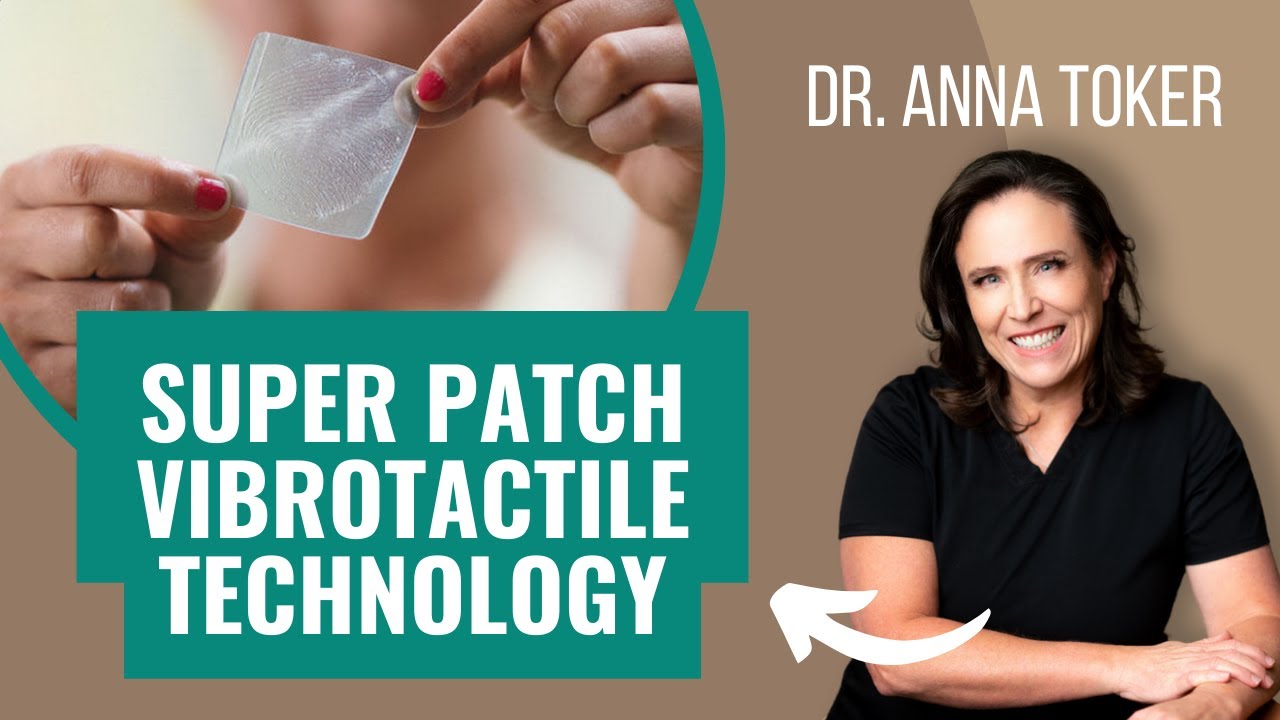Vibrotactile Technology Patches: A New Frontier in Sensory Interaction
Vibrotactile technology patches are revolutionizing the way we interact with the world around us. These small, discreet patches deliver precise vibrations to the skin, creating a range of sensations that […]

Vibrotactile technology patches are revolutionizing the way we interact with the world around us. These small, discreet patches deliver precise vibrations to the skin, creating a range of sensations that can be used for a variety of purposes. From pain management and rehabilitation to gaming and virtual reality, vibrotactile technology is rapidly expanding into new applications, promising a future where our senses are enhanced and our experiences are enriched.
The concept of vibrotactile technology has been around for decades, but recent advancements in materials, miniaturization, and wireless connectivity have made it possible to create patches that are both effective and user-friendly. These patches are designed to be comfortable and unobtrusive, allowing users to experience a wide range of tactile sensations without the need for bulky or cumbersome devices.
Introduction to Vibrotactile Technology Patches
Vibrotactile technology patches are innovative devices that utilize vibrations to deliver sensory feedback, enhancing various aspects of human interaction with technology and the environment. This technology has a wide range of applications, from gaming and healthcare to communication and accessibility.
Vibrotactile technology relies on the principle of stimulating the sense of touch through vibrations. These vibrations are created by tiny actuators embedded in the patches, which convert electrical signals into mechanical vibrations. These vibrations are then transmitted to the user’s skin, providing a tactile experience that can be interpreted by the brain.
History and Evolution of Vibrotactile Technology
The history of vibrotactile technology dates back to the early 20th century, with initial applications in telegraphy and communication systems. Early vibrotactile devices were bulky and limited in their capabilities. However, advancements in microelectronics and materials science have led to the development of smaller, more sophisticated vibrotactile devices, paving the way for their widespread adoption in various fields.
The evolution of vibrotactile technology has been driven by several factors, including:
- Miniaturization of components: Advancements in microelectronics have enabled the development of smaller and more powerful actuators, allowing for the creation of compact and wearable vibrotactile devices.
- Improved materials: The development of new materials, such as flexible polymers and piezoelectric materials, has enabled the creation of more comfortable and durable vibrotactile patches.
- Increased computational power: The increasing availability of powerful and affordable microprocessors has enabled the development of more sophisticated vibrotactile systems capable of generating complex vibration patterns.
Working Principles of Vibrotactile Technology Patches
Vibrotactile technology patches work by converting electrical signals into mechanical vibrations. The patches typically consist of several key components:
- Actuators: These are small, piezoelectric or electromagnetic devices that convert electrical signals into vibrations. They are responsible for generating the tactile feedback.
- Control unit: This unit receives signals from a connected device (e.g., smartphone, computer) and controls the actuators, determining the intensity, frequency, and pattern of the vibrations.
- Power source: The patches are powered by a small battery or by drawing power from the connected device.
- Adhesive backing: This allows the patch to be securely attached to the user’s skin, ensuring reliable contact and vibration transmission.
The intensity, frequency, and duration of the vibrations can be modulated to create different tactile experiences, allowing for the transmission of various types of information.
The vibration patterns generated by the patches can be programmed to convey specific information, such as:
- Direction: Different vibration patterns can be used to indicate direction, such as left or right, up or down.
- Magnitude: The intensity of the vibrations can be used to represent the magnitude of a signal, such as the strength of a force or the intensity of a sound.
- Timing: The timing and sequence of vibrations can be used to convey information about events, such as the arrival of a notification or the occurrence of a specific action.
Components and Design of Vibrotactile Patches
Vibrotactile patches are innovative devices that leverage the sense of touch to deliver various functionalities. They are composed of several key components, each playing a crucial role in their operation and effectiveness. Understanding these components and the design considerations involved is essential for optimizing the performance and user experience of these patches.
Vibrotactile Actuators
Vibrotactile actuators are the core components responsible for generating the vibrations that stimulate the skin. These actuators convert electrical signals into mechanical vibrations, which are then transmitted to the user’s skin. Different types of actuators are employed in vibrotactile patches, each with its unique characteristics and advantages.
- Electromagnetic Actuators: These actuators utilize an electromagnetic coil to generate vibrations. They are known for their high power output and ability to produce a wide range of frequencies. However, they can be relatively bulky and consume significant power.
- Piezoelectric Actuators: These actuators use piezoelectric materials that expand and contract when subjected to an electric field. They are known for their small size, low power consumption, and fast response times. However, they may have limited power output compared to electromagnetic actuators.
- MEMS (Micro-Electro-Mechanical Systems) Actuators: These actuators are fabricated using micro-machining techniques and are extremely small and lightweight. They offer high precision, low power consumption, and fast response times, making them suitable for applications requiring high spatial resolution.
The choice of actuator depends on the specific application requirements, such as the desired vibration frequency, amplitude, power consumption, and size constraints.
Placement and Size Considerations
The placement and size of vibrotactile patches are crucial factors influencing their effectiveness and user experience. Optimal placement ensures that the vibrations are delivered to the desired location on the skin, maximizing the sensory feedback.
- Targeted Stimulation: The placement of the patches should align with the specific areas of the skin where the intended sensory feedback is desired. For example, patches for haptic feedback in mobile devices may be placed on the back of the hand or fingers, while those for medical applications might be positioned on specific body parts for pain management or muscle stimulation.
- Patch Size and Density: The size of the patches should be carefully considered to ensure comfortable and effective stimulation. Larger patches may provide a broader area of stimulation, while smaller patches can offer greater precision and localized feedback. The density of actuators within a patch also influences the intensity and spatial resolution of the vibrations.
- Skin Sensitivity: The sensitivity of the skin varies across different body regions. Patches should be placed on areas with higher sensitivity to ensure optimal perception of the vibrations.
These design considerations play a crucial role in maximizing the effectiveness and user experience of vibrotactile patches.
Applications of Vibrotactile Technology Patches
Vibrotactile technology patches have emerged as a versatile tool with applications across various fields, including medical, consumer electronics, and beyond. These patches, capable of delivering precise and targeted vibrations, offer unique advantages in enhancing user experiences, improving health outcomes, and facilitating new forms of communication.
Medical Applications, Vibrotactile technology patches
Vibrotactile patches have shown promise in enhancing medical treatments and patient care. These patches can provide a range of therapeutic benefits by stimulating the skin and delivering targeted vibrations to specific areas of the body.
- Pain Management: Vibrotactile patches can be used to alleviate pain by stimulating the nerves and blocking pain signals from reaching the brain. They are particularly effective in managing chronic pain conditions, such as arthritis, neuropathy, and musculoskeletal pain. For example, researchers have found that vibrotactile patches can significantly reduce pain levels in patients with osteoarthritis of the knee, providing a non-invasive alternative to traditional pain medications.
- Rehabilitation: Vibrotactile patches can be used to improve motor function and coordination in patients recovering from stroke, spinal cord injury, or other neurological conditions. By providing sensory feedback, these patches help individuals regain control over their limbs and improve their ability to perform everyday tasks. Studies have shown that vibrotactile patches can enhance hand dexterity, balance, and gait in individuals with neurological impairments.
- Sensory Feedback: Vibrotactile patches can provide sensory feedback to individuals with sensory impairments, such as blindness or deafness. For instance, they can be used to create tactile maps for blind individuals or to alert deaf individuals to important sounds. Researchers are exploring the use of vibrotactile patches in prosthetic limbs to provide users with a sense of touch and improve their ability to interact with the environment.
Consumer Electronics
Vibrotactile technology patches have found their way into various consumer electronics, enhancing user experiences and creating new possibilities for interaction.
- Gaming: Vibrotactile patches can be integrated into gaming controllers or wearable devices to provide immersive haptic feedback, enhancing the player’s sense of presence and immersion in the game. They can simulate the feeling of textures, impacts, and other in-game events, creating a more realistic and engaging gaming experience. For example, a vibrotactile patch placed on a player’s hand could provide a realistic sensation of holding a weapon or feeling the impact of an explosion.
- Wearable Devices: Vibrotactile patches can be incorporated into smartwatches, fitness trackers, and other wearable devices to provide notifications, alerts, and other forms of feedback. They can gently vibrate to alert the user of incoming calls, messages, or other important events, offering a discreet and unobtrusive way to stay connected. Additionally, they can be used to provide personalized health insights, such as reminders to move, drink water, or take medication.
- Virtual Reality: Vibrotactile patches can enhance the immersive experience in virtual reality (VR) applications by providing tactile feedback that complements the visual and auditory stimuli. They can simulate the feeling of touching objects, interacting with virtual environments, and experiencing physical sensations within the virtual world. For instance, a vibrotactile patch placed on the user’s hand could simulate the feeling of picking up a virtual object or feeling the texture of a virtual surface.
Other Applications
The potential applications of vibrotactile technology patches extend beyond medical and consumer electronics, reaching into various fields, offering innovative solutions and possibilities.
- Communication: Vibrotactile patches can be used to create new forms of communication, especially for individuals with disabilities or in noisy environments. They can transmit messages, alerts, or even simple emotions through patterns of vibrations, providing a silent and discreet communication channel. For example, a vibrotactile patch could be used to communicate with someone in a noisy factory or to provide discreet alerts for individuals with hearing impairments.
- Education: Vibrotactile patches can be used to enhance learning experiences, particularly for students with learning disabilities or who are visually impaired. They can provide tactile feedback to reinforce concepts, create interactive learning environments, and make educational materials more accessible. For instance, a vibrotactile patch could be used to help students learn Braille or to provide tactile feedback during a science experiment.
- Security: Vibrotactile patches can be used to enhance security systems by providing discreet alerts and notifications. They can be integrated into wearable devices or implanted in objects to alert users of potential threats or security breaches. For example, a vibrotactile patch could be used to alert a security guard of an intruder or to notify a user of a suspicious activity in their vicinity.
Advantages and Limitations of Vibrotactile Technology Patches

Vibrotactile technology patches offer a unique and innovative approach to delivering sensory feedback, bringing with them a range of advantages and limitations. This section will delve into the benefits of using vibrotactile patches, highlighting their potential to enhance user experiences, accessibility, and overall well-being. It will also explore the challenges associated with these patches, including potential discomfort, battery life, and customization options.
Advantages of Vibrotactile Technology Patches
Vibrotactile technology patches offer several advantages that make them a promising tool in various applications.
- Improved User Experience: Vibrotactile feedback can significantly enhance user experience by providing intuitive and engaging interactions. For instance, in gaming, these patches can create realistic sensations of impact, vibration, or texture, immersing players in the virtual world. Similarly, in virtual reality, they can enhance the feeling of presence and realism by simulating physical touch.
- Enhanced Accessibility: Vibrotactile patches can be instrumental in improving accessibility for individuals with disabilities. They can provide alternative sensory feedback for those with visual or auditory impairments, enabling them to interact with devices and environments more effectively. For example, they can be used to alert visually impaired individuals about incoming calls or notifications or provide haptic feedback for navigating menus and interfaces.
- Non-Invasive Nature: Vibrotactile patches are non-invasive, meaning they do not require any surgical procedures or injections. This makes them a safe and convenient option for a wide range of users, including those who may be hesitant about more invasive technologies.
- Versatile Applications: Vibrotactile patches have a wide range of potential applications, extending beyond gaming and accessibility. They can be used in healthcare for pain management, rehabilitation, and therapy. In education, they can be incorporated into interactive learning tools to provide engaging and immersive experiences. Additionally, they can be used in smart homes and wearable devices to provide notifications, alerts, and other sensory feedback.
Limitations of Vibrotactile Technology Patches
While vibrotactile patches offer numerous advantages, they also come with certain limitations that need to be addressed.
- Potential Discomfort: The intensity and frequency of vibrations can cause discomfort for some users, especially during prolonged use. This is particularly relevant for individuals with sensitive skin or underlying medical conditions. Careful consideration should be given to the design and implementation of vibrotactile patches to minimize discomfort and ensure user comfort.
- Battery Life: The battery life of vibrotactile patches is a significant concern. The need for frequent charging can limit their practicality, especially for applications that require continuous use. Ongoing research and development are crucial to improve battery efficiency and extend the operating time of these devices.
- Limited Customization: Vibrotactile patches often have limited customization options, restricting the range of sensations and patterns that can be delivered. This can be a drawback for applications requiring a high degree of personalization or precise control over the vibrotactile feedback. Future developments in vibrotactile technology should focus on expanding customization capabilities to enhance user experience and meet diverse needs.
Future Trends and Innovations in Vibrotactile Technology Patches
The field of vibrotactile technology is constantly evolving, driven by advancements in materials, miniaturization, and wireless connectivity. These innovations are paving the way for more sophisticated and versatile vibrotactile patches with wider applications across various domains.
Improved Materials and Miniaturization
The development of advanced materials is a key driver of progress in vibrotactile technology. New materials with improved properties, such as enhanced conductivity, flexibility, and biocompatibility, are being explored to create more efficient and comfortable patches. Miniaturization is another crucial aspect, enabling the development of smaller and more discreet patches that can be seamlessly integrated into clothing, accessories, or even implanted under the skin.
- Flexible and Stretchable Materials: Researchers are investigating the use of flexible and stretchable materials like elastomers and conductive polymers to create patches that conform to the contours of the body, ensuring a comfortable and secure fit. This will enable the development of patches that can be worn for extended periods without discomfort.
- Biocompatible Materials: For applications involving direct skin contact or even implantation, biocompatible materials are essential to minimize the risk of allergic reactions or tissue rejection. Research is focusing on developing materials that are not only safe but also have a long lifespan, ensuring the longevity of the patches.
- Miniaturization and Integration: Advances in microelectronics and nanotechnology are facilitating the development of smaller and more powerful actuators and sensors. This allows for the creation of miniaturized patches that can be seamlessly integrated into wearable devices, clothing, or even implanted under the skin. For example, researchers have developed micro-actuators that are just a few millimeters in size, enabling the creation of patches that are barely noticeable.
Integration with Emerging Technologies
Vibrotactile technology is poised to benefit from integration with other emerging technologies, such as artificial intelligence (AI) and augmented reality (AR). These integrations will unlock new functionalities and applications for vibrotactile patches, expanding their reach beyond traditional sensory feedback.
- AI-powered Vibrotactile Patches: AI algorithms can be integrated into vibrotactile patches to personalize the feedback based on individual preferences, learning patterns, and even anticipating user needs. For instance, an AI-powered patch could learn the user’s walking patterns and provide gentle vibrations to correct their posture or warn them of potential hazards.
- Augmented Reality and Vibrotactile Feedback: Combining vibrotactile technology with AR can create immersive experiences by providing haptic feedback that complements visual cues. This can be applied in various fields, such as gaming, education, and training. Imagine a surgeon using an AR-guided surgery system with vibrotactile feedback to provide real-time guidance and tactile sensations during complex procedures.
Conceptual Vibrotactile Patch with Innovative Features
Imagine a futuristic vibrotactile patch that integrates the latest advancements in materials, miniaturization, and emerging technologies. This patch could be a thin, flexible, and biocompatible device that adheres seamlessly to the skin. It would be equipped with a network of micro-actuators capable of delivering precise and nuanced vibrations, simulating a wide range of tactile sensations.
- Personalized Feedback: The patch would utilize AI algorithms to learn the user’s preferences and adjust the intensity, frequency, and pattern of vibrations to provide personalized feedback. This could be used for various applications, such as fitness tracking, pain management, and even emotional regulation.
- Wireless Connectivity: The patch would connect wirelessly to smartphones or other devices, allowing users to control the feedback and receive real-time information. This would enable the development of applications that provide personalized guidance, warnings, and even social interactions through tactile sensations.
- Multi-sensory Integration: The patch could be integrated with other sensors, such as temperature sensors, pressure sensors, and even bio-sensors, to provide a more comprehensive understanding of the user’s environment and internal state. This could be used for applications such as health monitoring, environmental awareness, and even gaming.
Final Thoughts
Vibrotactile technology patches represent a significant leap forward in our understanding of human perception and interaction. Their ability to deliver precise and nuanced tactile feedback opens up a world of possibilities for enhancing our lives, from improving our health and well-being to creating more immersive and engaging experiences. As the technology continues to evolve, we can expect to see even more innovative applications emerge, further blurring the lines between the physical and digital worlds.
Vibrotactile technology patches are an exciting new development in the field of human-computer interaction. They offer a unique way to provide feedback and information through gentle vibrations, opening up new possibilities for everything from gaming to medical applications. To fully understand the potential of this technology, it’s essential to consider the broader context of introduction to business and technology , as it influences the development, adoption, and ultimately, the impact of vibrotactile patches on our lives.








